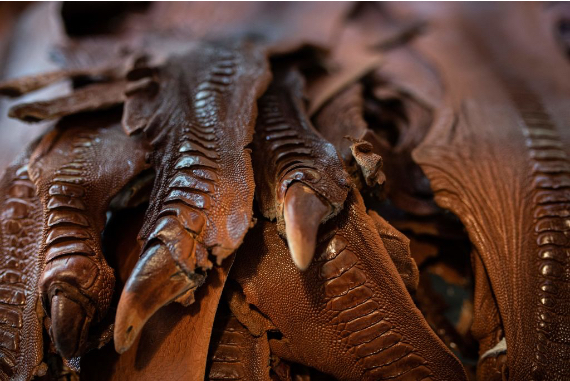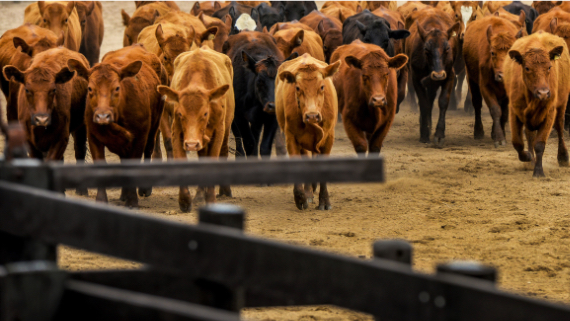Leather is possibly the oldest material used by humans for clothing. Exploited in parallel to meat for consumption, it is still very much present in our clothing, footwear, accessories and countless other uses. But with sustainability increasingly on the radar, is leather an environmentally friendly material? If you ask the leather industry, the answer will undoubtedly be yes; if you ask animal welfare groups, the answer will be a resounding no. But as always, there is an infinite amount of nuance.
On the Atlantic coast south of Rabat, the Moroccan capital, lies Contrebandiers Cave, an enclave that was already inhabited by our Homo sapiens ancestors 120,000 years ago. In 2021, archaeologist Emily Hallett and her colleagues found dozens of bone tools there, and their similarity to tools found at other sites and to their modern counterparts reveals their use: working fur and leather, in this case from jackals, foxes and wildcats. And it is possible that hominin species before our own were working leather in other regions of Africa.

From the Neolithic period, around 12,000 years ago, livestock farming provided a stable source of hides for leather making, using animals reared for food. Tanning—a chemical treatment that modifies the protein structure of leather to prevent decomposition—began at least 7,000 years ago in Sumer, and plant tannins, but also animal brains and faeces, are known to have been used in ancient Egypt. The Industrial Revolution introduced new tanning compounds, and in the 1850s chrome tanning, the most widely used today, was introduced.
The environmental risk of leather
The environmental footprint of leather is split between the raw materials—the animals— and the processing, which includes tanning. With regard to the former, and given that the hides for leather are generally obtained from livestock, it is worth remembering that livestock farming is one of the activities with the largest carbon footprint. The usual figure, according to estimates by the Food and Agriculture Organisation of the United Nations (FAO), is that the life cycle of livestock farming is responsible for 14.5% of anthropogenic greenhouse gas (GHG) emissions that cause climate change, although more recently the FAO itself has lowered its estimate to 12%, while other studies have raised the figure to almost 20%.

For its part, the industry defends itself with an argument: according to Leather Naturally, a global industry association based in the Netherlands, leather “is made from a by-product of the food industry. If this by-product were not converted into leather, it would be thrown into a landfill, a significant environmental risk.” It is sometimes suggested that the entire carbon footprint, as well as deforestation and water footprints, can be attributed to the production of meat and milk. Leather Panel, part of the UN Industrial Development Organisation (UNIDO), adds that “demand for leather has no impact on the number of animals slaughtered.”
But other experts disagree. In a report published in 2022, the Australian-based Collective Fashion Justice (CFJ), which advocates for ethical fashion and is part of the UN Fashion and Lifestyle Network, states that “leather is not a by-product” but a co-product with value in its own right; for CFJ, it is misleading to attribute the entire carbon footprint to meat and milk, as the leather trade assumes a share of the economic sustainability of livestock farming. For example, the sale of hides offsets the loss of male calves in the dairy industry. According to Leather Panel, the total carbon footprint of leather is 110 kilos of CO2 per square metre, of which only 17 kilos comes from the manufacturing process; the rest is from the farm.

But not all leather originates from traditional livestock farming; there is also leather from crocodiles, snakes and other exotic animals. Again, there is no consensus. While some experts argue that this demand fuels the illegal trade in species, others claim that the exploitation of snakes or crocodiles for their skins helps to conserve them. According to biologists and conservationists Daniel Natusch, Grahame Webb and Rick Shine, “commercial harvesting gives local people—often very poor people—a direct financial incentive to conserve reptile populations and the habitats upon which they depend.”
New greener processes and sustainable alternatives
In any case, leather has to be tanned, and this involves the use of chromium salts and up to 170 potentially harmful products, according to CFJ, as well as the generation of hydrogen sulphide, ammonia and other waste. The search for new, greener processes—vegetable tannins do not improve leather’s environmental scorecard, according to one study—is one of the demands of the industry, which Leather Naturally says is “committed to eliminating potentially harmful substances from the supply chain.” Leather Naturally claims that leather is biodegradable in 10 to 50 years, that it is recycled into fibres for footwear and other uses, and that several countries have sustainability certifications.
In the face of all this, CFJ accuses the industry of greenwashing: the Higg Index, created by the Sustainable Apparel Coalition to assess the sustainability of materials in the fashion industry, ranks cowhide as the third most environmentally damaging material after silk and alpaca wool—something the industry denies—claiming that the Higg Index overestimates the environmental impact of leather by no less than 8,000 times.

What about alternatives? Much of today’s synthetic leather is made from polyurethane, a petroleum-based plastic. Even here, CFJ claims that a pair of cowhide boots has a carbon cost almost seven times greater than a pair made from synthetic leather; other sources support the same seemingly paradoxical idea that synthetic leather is more environmentally friendly. But the future offers new options: vegetable leathers made from tea, corn, pineapple leaves, cactus or mushrooms, or bioplastics, are now being introduced to replace plastics.
Comments on this publication